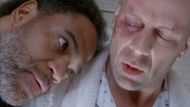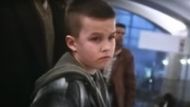Terry Gilliam’s 12 Monkeys was released in 1995. The story is very tricky and confusing, with ideas about time travel, fate, and memories. The main character, James Cole, gets trapped in a loop of time where the past, present, and future all mix together.
The movie shows time as a kind of prison — one that is not just physical but also messes with people’s minds and hearts. It makes you question if people can ever really change anything, or if everything is already decided.
What is 12 Monkeys about?
12 Monkeys is a science fiction film. It depicts a post-apocalyptic world where a fatal virus killed nearly everyone. The survivors in 2035 inhabit the underground areas.
Researchers need to know where the virus originated. They send a convict named James Cole into the past to collect information on the virus.
But something goes awry. Cole gets dispatched to the wrong year, 1990, rather than 1996. Naturally, people think he is crazy as he talks about a deadly virus, so they put him in a mental asylum.
There, he encounters Jeffrey Goines — a mentally unstable man. His dad is a scientist who specializes in viruses. Cole begins to believe that Jeffrey and his gang, the “Army of the Twelve Monkeys,” might be responsible for spreading the virus.
Cole is pulled back and forth through time. He even lands in World War I and gets injured.
Later, Cole finally arrives in 1996. He meets Dr. Kathryn Railly, a psychiatrist who had treated him before. She initially believes he is crazy, but soon discovers evidence that he could indeed be speaking the truth.
Cole and Railly pursue the “Army of the Twelve Monkeys.” They find out that the group did not start the virus. They simply freed animals from a zoo as a protest.
Dr. Peters is the individual responsible for the virus. Dr. Peters serves as an assistant to Jeffrey’s father.
Finally, Cole attempts to stop Dr. Peters at an airport. However, before he can do anything, police shoot and kill Cole. It is witnessed by his younger self.
Dr. Peters manages to escape and boards a plane to spread the virus. However, a scientist from the future sits next to him. There’s a slim chance they’ll be able to stop him.
But, if everything is predestined and everything lays the road for something that is unavoidable, do we truly have free will?
12 Monkeys and the characters who are trapped in time
One timeline and no changes
In 12 Monkeys, there is only one timeline. The past can’t be changed. The scientists don’t send Cole back to stop the virus. They just want information.
As Screen Rant summarizes:
“...there is exactly one timeline in 12 Monkeys. Unlike other time travel stories, like the Back to the Future trilogy, alterations can't be made to time in 12 Monkeys. Things always happen how they happened, and that's that.”
This rule makes the movie very dark. While the characters must act, they can’t stop the disaster.
James Cole’s experience of time is confusing. He jumps between the future, the past, and even World War I.
The airport scene repeats five times — sometimes as a dream, sometimes as a memory, and finally as real life.
The movie poses a profound question: if time is a loop, are we free at all?
The time loop: Memory and fate

Firstly, the airport is the most important scene. Cole sees his own death as a child — a memory that comes true.
This shows time as a circle.
Cole is stuck watching and living the same event. His memory becomes a trap he can never escape.
Second, Cole’s personal timeline doesn’t match the world’s timeline.
He meets his younger self and lives through the same moment twice. He feels out of place, always chasing the past or the future.
Third, Cole’s task is not to alter the past, but to ensure it happens. Dr. Cassandra Railly embodies this as well.
Her name is a reference to the “Cassandra Complex,” in which a person speaks the truth about the future, but nobody listens.
Railly and Cole both know what will happen but are unable to prevent it. Their warnings are disregarded, and their actions actually contribute to the events they wish to prevent.
Their knowledge becomes a curse.
Being trapped: Madness and control
People think Cole is insane. He doubts himself, too. At one point, he believes he’s just crazy and imagined everything.
The movie shows how hard it is to tell the truth from madness when nobody believes you.
In the future, Cole is being watched all the time. He has no freedom. The mental hospitals are just as controlling.
The movie compares science, psychiatry, and surveillance, all of which take away personal freedom.
As a Swarthmore College analysis points out:
“12 Monkeys also directly confronts surveillance and only disenfranchised characters are able to occupy a prophetic space in which they control the camera”
The virus: More than just a disease

In 12 Monkeys, the virus is not merely a part of the narrative. It symbolizes social and psychological trauma. The film is set in Philadelphia, linking it to genuine fears regarding the AIDS epidemic.
As with AIDS, the virus equals fear, stigma, and societal breakdown.
Furthermore, the same Swarthmore College paper points out:
“...film itself can function as a kind of time travel and provide a new metaphysical understanding of life and death in the face of pandemics.”
Is the loop really unbreakable?
Most people think the past can’t change in 12 Monkeys. Some fans argue that Cole’s actions may change small things.
Others say any change would break the whole timeline, and the movie avoids that.
As one Reddit user notes:
"If Cole is changing things in the past, then it seems unlikely he'd would, way in the future always be in the same situation to be be sent back again and again. A small change in the past would/could have huge effects on the future."
In addition, the conclusion of 12 Monkeys is ambiguous. A man from the future sits beside the virus carrier on an airplane.
Some interpret it as a glimmer of hope — perhaps the future can be altered. Others say it indicates that the characters are trapped in the same cycle, acting out a script they cannot break.
Comparing 12 Monkeys to other time loop stories

2 Monkeys is based on the short film La Jetée. Both stories deal with memory, death, and time loops. But 12 Monkeys adds deeper psychology and social themes.
In movies like Groundhog Day or Back to the Future, characters can fix things. In 12 Monkeys, they can’t. The loop is a trap, not a problem to solve.
The characters here are stuck. Their choices don’t change anything. The movie asks: if the future is set, are we really free?
The movie shows trauma as something that repeats forever. Cole relives his death again and again. He cannot escape his past.
The loop as metaphor and reality
12 Monkeys traps its characters — and its viewers — in a loop. The film depicts a world in which time cannot be altered. Memories trap individuals. Free will is an illusion.
The film makes us consider how little we have control over — and how some losses are inevitable.
But even in this story, there are moments of connection and beauty. The final scene — a child watching his future self die — is sad but powerful.
It reminds us that even in a world we can’t control, memory and art still matter.
Love movies? Try our Box Office Game and Movie Grid Game to test your film knowledge and have some fun!
